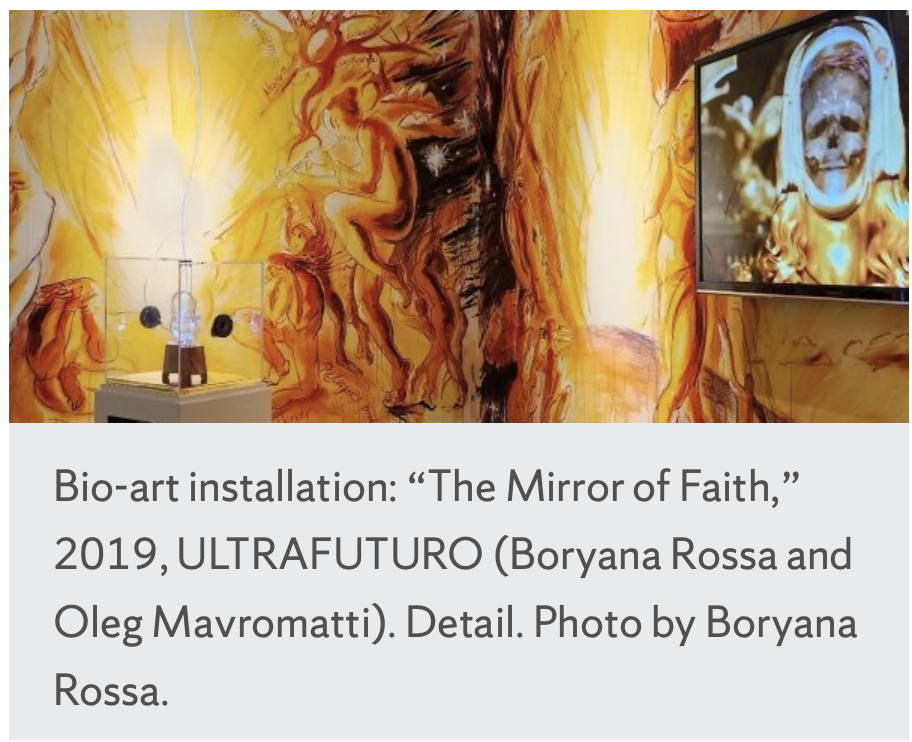I’m excited to be at Syracuse University where building connections between the arts and sciences is empowered. Check out the article here and reach out if you're interested: SU’s BioInspired adds research subgroup blending Arts, Sciences and Humanities.
CHIMERA- Syracuse University's first Bio-Art Show
I'm so excited to help out with this Bio-Art show with Boryana Rossa and our fabulous students. If you are in the Syracuse Area, come check it out.
CHIMERA:
This exhibition features finished works and works in progress that have been made by students and artists who utilize techniques and knowledge from the field of biological sciences, apply discussion from humanities and look for visual and textual expression that comes from the arts.
During the global pandemic, the need for an integrated approach to education that includes both art and science has become imperative for fighting collective distrust in science. Our attempt is to create widely accessible view of the work done in scientific labs and open discussion about its social importance that comes from both sciences and the arts.
While taking the bio-art class the students, who have scientific or artistic backgrounds, studied examples of bio-art, had hands-on experience with microscopy and other biological techniques, and discussed their work reaching beyond their disciplines. The works in the exhibition present varieties of topics, starting with self-portraits, portraits of ecological systems, visual exploration of macro and micro worlds, ethical and personal exploration of the role of the scientist in the society, and the body as a political arena.
Guest artists are presented with signature and award-winning works. Jennifer Willet looks at the topic of co-existence, play and collaboration of human and microbial worlds, Paul Vanouse reflects upon industrial society’s shift from human and machine labor to forms of microbial manufacturing, and Adam Zaretsky presents “The Errorarium,” a device for exploring the gamification of the forced genetic errors that may appear in chamber-grown botanica.
CIMERA is part of the programming of the Bio-Art Mixer, where art and life sciences meet, faculty and grads share their research or look at it from the perspective of a different discipline. Initiated by Heidi Hehnly, Ph.D. Biology, SU; Boryana Rossa Ph.D. FMA.
Supported by CUSE Seed Grant, Department of Film and Media Arts and Department of Biology.
We had an exceptional BioArt on Dec 11!
A great time was had with presentations by Jennifer Willet (School of Creative Arts, University of Windsor, Canada), Rich Pell (School of Art, Carnegie Mellon University, PA) and Joseph Paulsen (Department of Physics, Syracuse University).
Jennifer Willet Ph. D. (School of Creative Arts, University of Windsor, Canada)
INCUBATOR Lab: Re-imagining biotech futures through bio-art practices
INCUBATOR Lab is a bio-art research and teaching facility in the School of Creative Arts at the University of Windsor in Canada. Founded in 2009 by Dr. Jennifer Willet, INCUBATOR Lab houses ongoing student and faculty bio-art projects, and science and technology studies research, and special events investigating the intersection of biotechnology, art and ecology. In this presentation, Willet will introduce the audience to INCUBATOR facilities, research methods, and activities and highlight a few of her artworks produced within this research laboratory framework.
Dr. Jennifer Willet is an artist and a Canada Research Chair in Art, Science, and Ecology and an Associate Professor in the School of Creative Arts at the University of Windsor (Canada.) Willet is Director of INCUBATOR Lab an art/science research laboratory and studio in downtown Windsor. She is an internationally successful artist and curator in the emerging field of bio-art. Her work resides at the intersection of art and science and explores notions of representation, the body, ecologies, and interspecies interrelations in the biotechnological field.
Richard Pell (School of Art, Carnegie Mellon University, PA)
Richard Pell is Curator at the Center for PostNatural History in Pittsburgh, Pennsylvania. Founded in 2010, the Center for PostNatural History collects organisms that have been intentionally and heritably altered by humans by means including selective breeding or genetic engineering.
The CPNH operates a permanent museum in Pittsburgh, Pennsylvania, and produces traveling exhibitions that have appeared in science and art museums throughout Europe and the United States, including being the subject of a major exhibition at the Wellcome Collection in London. The CPNH has appeared in publications including National Geographic, Nature Magazine, American Scientist, Popular Science, New Scientist, The Guardian and Wired. The CPNH was awarded a Rockefeller New Media Fellowship, a Creative Capital fellowship, a Smithsonian artist research fellowship, and major financial support from Waag Society and the Kindle Project.
Joseph D. Paulsen Ph. D. (BioInspired Institute and Department of Physics, Syracuse University)
https://paulsengroup.wordpress.com/
We are all familiar with the wrinkled texture of a raisin or a candy wrapper. Studying the size and arrangement of wrinkles in controlled experiments on extremely thin plastic films can lend insight into these and other materials that wrinkle, from textiles to biological tissues to synthetic skins. My talk will discuss how we generate wrinkle patterns in the lab, and how we study them to uncover new physical principles.
Joseph has BAs in Mathematics and Physics from St. Olaf College in Northfield, MN, and a PhD in Physics from the University of Chicago. He won a National Science Foundation CAREER Award for his work that studies connections between geometry and mechanics in thin materials. A shameless plug: he is married to Jenna Paulsen who is a practicing landscape artist in Syracuse (jennapaulsen.com).
Recordings of our Bio-Art Mixers can be found here: https://bit.ly/2VwPeFl
The Bio-Art Mixer has been initiated by Heidi Hehnly, Ph.D. Biology, SU; Boryana Rossa Ph.D. Transmedia, SU in collaboration with Canary Lab.
Supported by CUSE seminar grant and Department of Transmedia, Syracuse University.
YouTube channel of the Bio-Art Mixer: https://www.youtube.com/channel/UCzSiw8w4xmNEhMb2W7xyvoQ
Also check out the article in SU News at: https://thecollege.syr.edu/news-all/news-2020/bio-art-mixer-where-art-and-sciences-meet/


